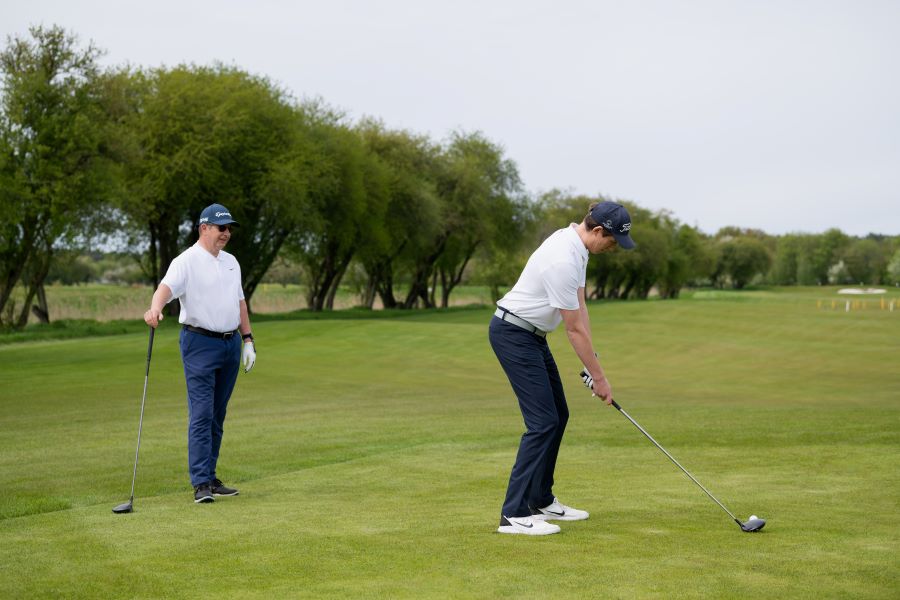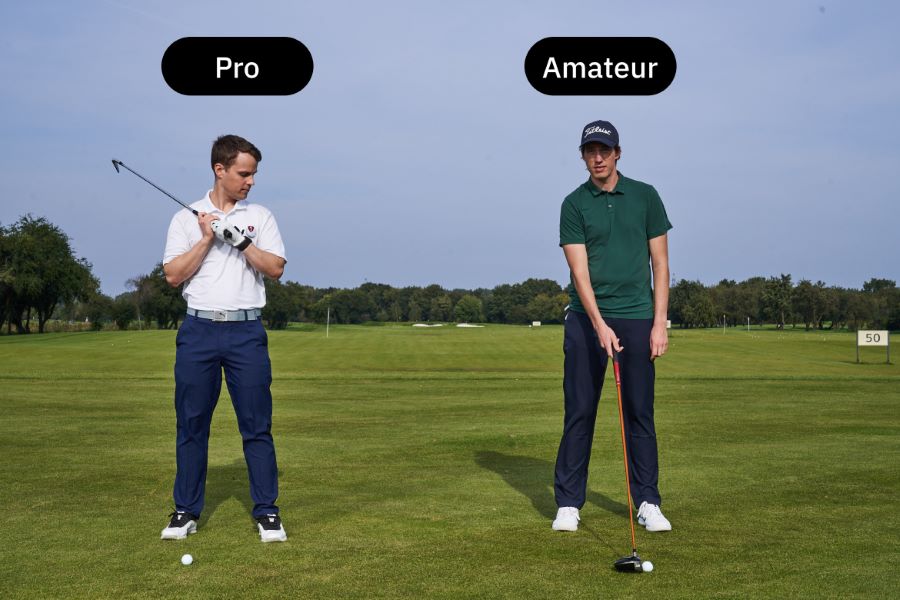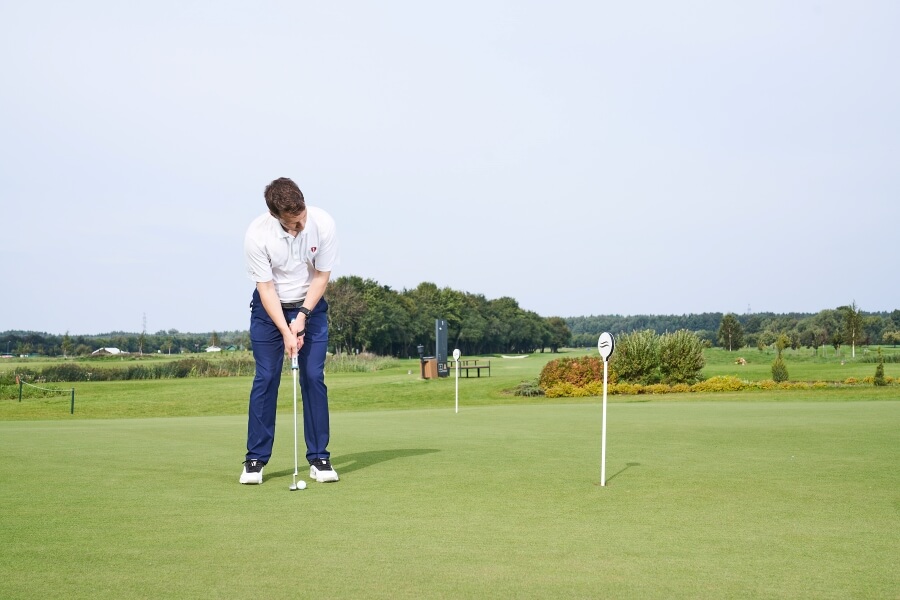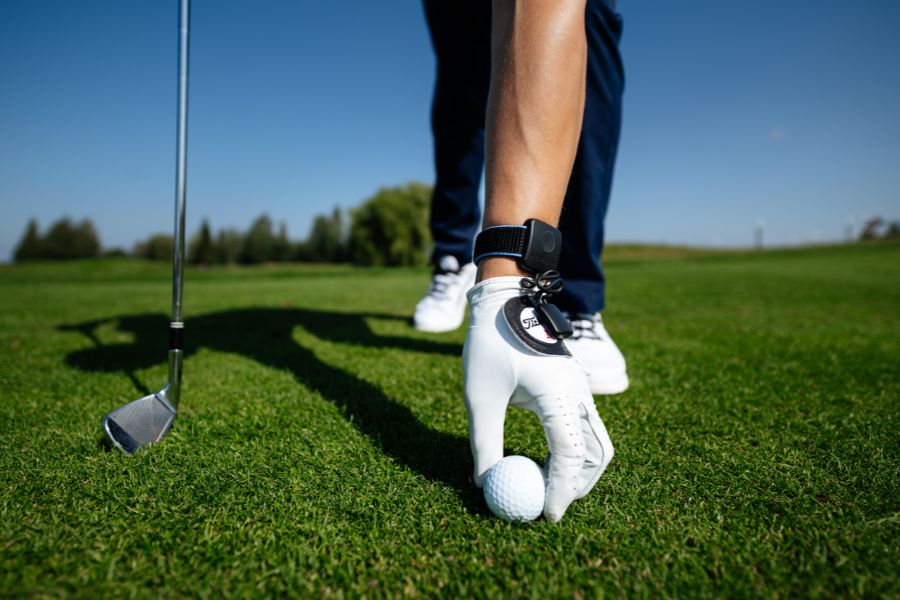How to Be More Consistent in Golf: 12 Actionable Tips & Drills to Unlock Consistency
Shooting a 73 feels amazing, but following it up with an 83 can be incredibly frustrating. Can you relate?
Perhaps you’ve broken 100 once but can’t seem to do it again, or maybe you play the front nine 2 over and the back nine 10 over.
Consistency in golf is the dream of every enthusiast.
This article will show you what it takes to become a more consistent player, why inconsistency creeps in, and what you can do to keep your game steady from one day to the next.
How to Become Consistent in Golf (Key Takeaways)
To become consistent in golf, you need certain skills and knowledge. Here are some key takeaways for achieving consistency in your game:
- Incorporate Technology: Incorporate technology into your golf practice routine, especially technology that offers real-time feedback.
- Check Grip Consistency: Check on grip consistency, which is often more important than grip position.
- Maintain Rhythm and Tempo: Rhythm and tempo should be nearly the same every time, regardless of the club you have in your hand.
- Use a Pre-shot Routine: Always use a pre-shot routine, develop it through practice, and stick to it.
- Focus on Clubface Angle: Focus on the clubface angle at impact and how your wrists control that. Having some flexion in the lead wrist can help deliver the club square each time.
- Engage Larger Muscles: Incorporate your larger muscles into your golf swing; shoulder and hip rotation can keep your swing more consistent.
- Keep a Flat Lead Wrist: Keep a flat lead wrist at impact and bring the HackMotion with you to the range when you practice to record progress and work on drills.
Contents
- 12 Actionable Tips to Achieve Greater Consistency in Golf
- 1. Get a Lesson to Get You Started (From Humans or Technology)
- 2. Consistent Grip on the Club Each Time
- 3. Master Clubface Alignment
- 4. Correct Ball Position
- 5. Improved Posture and Wrist Position
- 6. Fine Tune Rhythm and Tempo
- 7. Square the Clubface at Impact
- 8. Work On Your Chipping and Pitching
- 9. Learn How to Read Greens
- 10. Develop a Consistent Putting Stroke
- 11. Employ a Pre Shot Routine
- 12. Use the Correct Shaft for Your Swing Speed
- Drills to Get More Consistent in Golf
- FAQs
- Final Thoughts
12 Actionable Tips to Achieve Greater Consistency in Golf
1. Get a Lesson to Get You Started (From Humans or Technology)
Hiring the services of an instructor for at least two or three lessons is well worth your month. A professional will examine your grip setup, swing path, clubface position at impact, rotation, and angle of attack.
After analyzing your setup, they will help you correct any weaknesses in your composition to eradicate the issue from your swing.
As an alternative, you can use HackMotion swing diagnostics (Guided Practice Feature). Take a few swings and let HackMotion pinpoint the exact issues that keep you from being a consistent player.
The great thing about the diagnostics is that you can return to it after you have spent some time correcting the issues in your game.
2. Consistent Grip on the Club Each Time
Many amateurs do not utilize a consistent grip and change the strength of it (weak/strong/neutral), leading to an erratic swing plane, club path, and shot shape.
Whether you use the Vardon, interlock, or ten-finger grip, I suggest starting with a neutral grip.
Work on setting your hands on the club and seeing if your grip position is consistent.
Use the HackMotion to monitor the extension/flexion in the lead wrist at setup and practice consistency.
Be aware of the weaker grip, which promotes an open clubface at impact.
This can exacerbate a slice but help mitigate hooks. A strong grip can prompt players to swing over the top and attack along a steep angle with a closed clubface.
3. Master Clubface Alignment
When setting up for your shot, ensure that your clubface points at your desired target.
Use golf alignment sticks on the ground for your feet, target, and clubface line. Ensure your clubface is aimed correctly as part of your pre-shot routine.
4. Correct Ball Position
As a rule of thumb, you position the ball forward in your stance for shots with longer shafted clubs and towards the middle or slightly in the back for wedges.
Drivers and fairway woods are longer and need more time to square up for a powerful strike. As a result, you place the ball forward for these shots. The forward position lets your driver reach the swing’s low point before striking the ball on the tee.
Mid and long irons are best positioned in the middle of your stance.
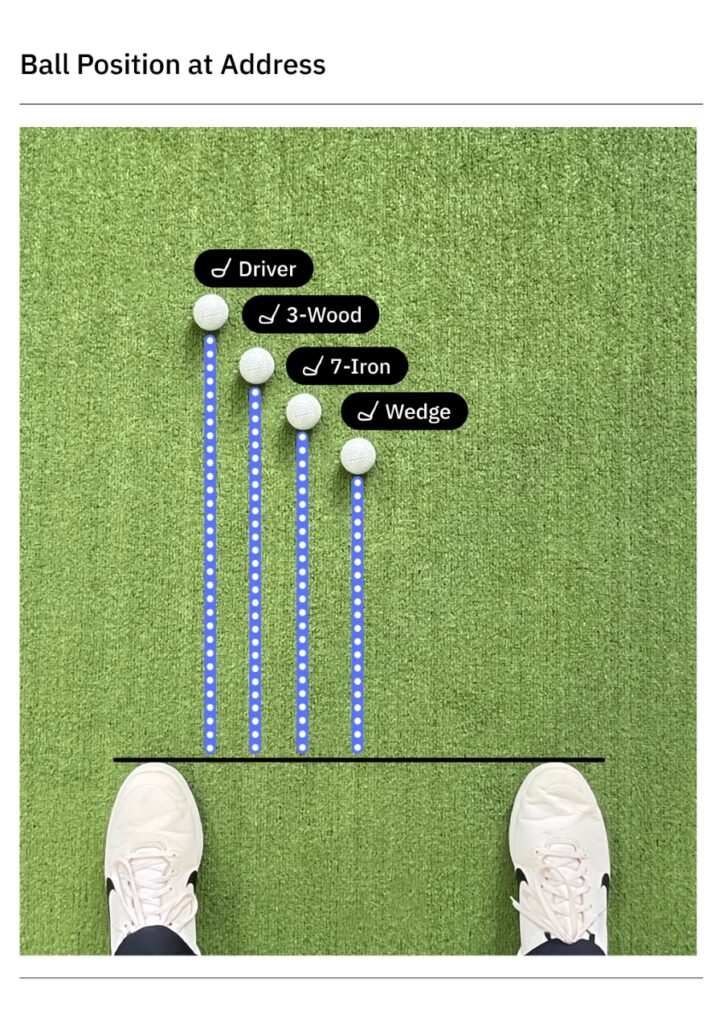
5. Improved Posture and Wrist Position
Correct posture allows your body to rotate as needed, keeping your club on the path and boosting power on the downswing.
Most amateur players tend to get too bent in their knee position, making it hard to attack the ball from the right angle. In golf, you want an athletic position, but if you are too bent over, it will change the swing plane.
In addition, make sure your wrists are set up correctly from the start. Letting the handle drop too low creates unnecessary wrist extension at setup.
6. Fine Tune Rhythm and Tempo
Rhythm and tempo help you develop a consistent swing.
Using a counting drill in your golf swing can help you to hit consistent golf shots. The number of counts you get to does not matter; it’s mostly the fact that you are being aware of timing and tempo.
Try something like swinging back while counting to three and then letting four be your downswing. Try it with a wedge, switch to a 7-iron, and finally a driver.
A swing that lacks rhythm and tempo results in an erratic transition from the top of the swing down, which can lead to a loss of power. While practicing with your HackMotion, check your swing tempo to see if you can keep it consistent.
7. Square the Clubface at Impact
It is easier said than done to square the clubface up at impact. However, to be a consistent golfer, there is no way around it.
The easiest way to square the clubface at impact is to get your lead wrist slightly flexed. Using the HackMotion, you can work on a drill called the Release drill.
Perfect Your Release with HackMotion
Fine-tune your release for consistent contact. Start with a short swing to master control before adding power.
HackMotion Release Drill – Step by Step
- Start with the club at address.
- Swing back to the position where the club is parallel to the ground.
- Check to make sure your lead wrist position is not too extended.
- Swing through impact to the position where the ball is parallel to the ground again.
- Check for feedback about impact position and the angle of the lead wrist, note ball flight.
- The goal is to have the lead wrist more flexed than set up and to have the hands leading the clubhead through impact.
Most amateur golfers struggle with a lead wrist that is too extended throughout the entire golf swing. If too much extension is at the top of the backswing, it’s nearly impossible to square the clubface at impact.
If you can get your swing (and your wrist angles) perfect from this parallel to parallel position, the rest of the swing is much easier.
Learn about lead wrist extension and flexion in our detailed guide here.
8. Work On Your Chipping and Pitching
Golf Magazine explains that 15 handicap golfers nail 26% of their greens in regulation, equivalent to 5 holes in an 18-hole round.
As a result, you need to chip to get up and down on 13 holes during the round. If your chipping game is lackluster, you leave yourself with a long-range par putt, which could effortlessly turn into a double bogey.
Aside from dedicating 30 to 60 minutes weekly to chip shots, bump and runs, bunker shots, and flops, you should also learn the different wrist positions needed to manufacture different types of greenside shots. When you want more height and increased spin, you may need a little wrist extension for impact.
This video from Rob Cheney will take you through how to start controlling the ball in your chips and pitches and become more consistent.
9. Learn How to Read Greens
When putting downhill, use a softer stroke to control the ball’s speed and avoid rolling it too far past the cup. For uphill putts, add more power to ensure it reaches the hole.
Pay close attention to the green’s slope and undulations. If it breaks sharply to the right, adjust your aim further left. As you approach the green, observe the overall slope and contours, not just the area immediately around the hole, to better anticipate how the ball will move.
Green reading is a big part of becoming a consistent putter, and it takes practice to get it down.
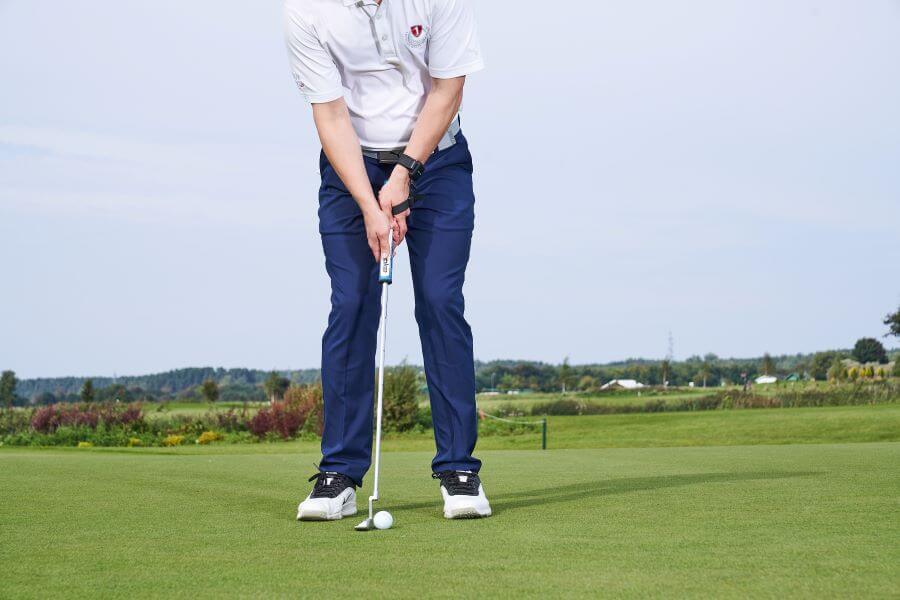
10. Develop a Consistent Putting Stroke
Once your green reading skills are on point, it is time to develop a consistent putting stroke.
Practice stabilizing the putter head during the stroke to square it at impact and start the ball on the intended line. Use HackMotion’s putting feature to work on putting stroke consistency.
We have found that the best putters in the game don’t have perfect strokes; they can just repeat the same action every single time. The Putting Stability feature in HackMotion will test your putting stroke and see how consistent it is.
11. Employ a Pre Shot Routine
A consistent pre-shot routine helps you clear your head and focus on your shot. It’s also great for visualization of your shot and swing.
When you have a pre-shot routine in place, you are essentially telling your body (and your brain) that you will execute a golf shot. Muscle memory in golf is a real thing, and the pre-shot routine can help.
When practicing at the driving range, use your pre-shot routine so that it becomes second nature to you.
12. Use the Correct Shaft for Your Swing Speed
Your golf shafts can affect the speed, spin, launch, and shot shape. If you utilize a golf shaft that is too stiff for your swing speed, you struggle to generate velocity on the downswing, leading to a weak strike and a loss of distance.
Conversely, when your shaft is too flexible for your swing speed, you may generate excess spring, speed, and spin, causing your ball to balloon.
Here are general guidelines based on swing speed for what shaft to use.
| Shaft Flex | Swing Speed (mph) | Player Type |
|---|---|---|
| Ladies (L) | < 70 | Slow swing speeds, beginners, or players needing more distance |
| Senior (A) | 70-85 | Moderate swing speeds, seniors, or players with smooth swings |
| Regular (R) | 85-95 | Average swing speeds, casual players, or balanced performance needs |
| Stiff (S) | 95-110 | Fast swing speeds, lower handicaps, or aggressive players |
| Extra Stiff (X) | > 110 | Very fast swing speeds, high-level players, or professionals |
Drills to Get More Consistent in Golf
Here are a few of the most effective drills to learn how to play more consistent golf.
Thumbs Down Short Game Drill
Too often, golfers are concerned with the position of the clubhead instead of the position of their body. If you struggle with a consistent short game, try this thumbs down drill from Rob Cheney.
It helps keep your wrists from flipping or rotating incorrectly.
Wrench Drill
If you are one of those players struggling with your golf game due to excessive movement, then the wrench drill could be the place to start.
This drill involves putting the majority of your weight on your lead foot and then rotating the lower body as you would turn a wrench. This helps achieve a cleaner and more consistent strike.
Motorcycle Drill
The Motorcycle drill is probably the most well-known wrist drill in the game.
For golfers who are losing power or are leaving themselves with an open clubface at impact, the motorcycle drill is a perfect solution.
Motorcycle Drill – Step by Step
- Start with your normal setup.
- Swing to the top of the backswing.
- On the way down, when transitioning from backswing to downswing, turn the lead wrist as if you are revving a motorcycle.
- Swing through impact and try again.
- Learning how to “rev” the grip on the downswing will make it easier to square the clubface sooner on the downswing.
Static Top Drill
If your clubface is not in the correct position at the top of your swing, it’s rare that you will get it in the right position at impact.
The static top drill is simple and a great place to start if you struggle with this top position.
Static Top Drill in HackMotion
By working on the Static Top Drill, you can create muscle memory and achieve a flat lead wrist at the top of the backswing.
Static Top Drill – Step by Step
- Start with your Clubface square at the address.
- Swing to the top of the backswing and see if you are in the green zone with your HackMotion.
- Adjust the wrists until you get into the green.
- Swing down to the ball and then reset yourself.
- Do this ten times until you can naturally swing back and be in the green position.
FAQs
Why am I suddenly terrible at golf?
The longer you play the game, the more you develop bad habits, which creep into every element of your swing mechanics. Golf is both a physical and mental game. If you have either physical or mental fatigue, you may need to take some time away from the game to rest.
Start tracking your golf game to pinpoint the areas causing the higher scores.
Why is my golf game so inconsistent?
The golf club is in an incorrect position at impact, making your golf game more inconsistent. Work on creating an impact position with a slight flex in the lead wrist to ensure a square and stable clubface.
Why is it hard to be consistent in golf?
It is hard to be consistent in golf because it requires optimal aim, an appropriate grip setup, the correct ball position, and a rhythmic swing.
How do I stop being inconsistent in golf?
You stop being inconsistent at golf by working with an instructor, developing a consistent grip setup, and placing the ball optimally in your stance.
In addition, you must work on producing a rhythmic swing where the club is on the proper plane. Golf drills where you can work on your swing in real time are beneficial.
How often should I golf to improve?
Ideally, you should play golf once a week and practice for 1 to 2 hours to improve.
This leaves you with sufficient time to work on your long, mid, and short game on the range and put it into action once a week.
After your round, review your performance and create actionable steps to improve those weaknesses.
Why am I getting worse at golf the more I play?
You are getting worse at golf the more you play because you are not fixing the fundamental issues in your setup and swing.
You are applying the same formula and hoping for it to improve. Instead, focus on the impact position and see what is causing the issues.
How do I regain confidence in golf?
Start using a pre-shot routine to help you focus on one shot at a time and stop beating yourself up over previous bad rounds. Set yourself small goals, like trying to hit two fairways in a nine, and forget about the score.
This mindset helps you focus on the positives and eradicate negativity to build towards regaining confidence.
Final Thoughts
The solutions to becoming more consistent in golf predominantly center around your grip setup, ball position, wrist position, posture, alignment, and rhythm. In addition, you must work on your chipping, learn to read greens, and employ a pre-shot routine for a clear mind on every swing.
Use the resources of a professional or a swing analyzer and interactive tool like HackMotion to get you on the right path.





